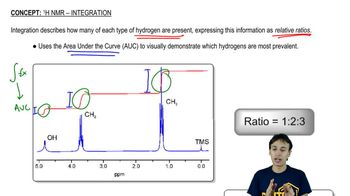Here are the essential concepts you must grasp in order to answer the question correctly.
Nuclear Magnetic Resonance (NMR) Spectroscopy
NMR spectroscopy is a powerful analytical technique used to determine the structure of organic compounds. It relies on the magnetic properties of certain nuclei, primarily hydrogen (1H) and carbon (13C), to provide information about the number of hydrogen atoms, their environment, and connectivity in a molecule. The resulting spectra display peaks that correspond to different chemical environments, allowing chemists to deduce structural information.
Recommended video:
Chemical Shifts
Chemical shifts in NMR spectra indicate the resonance frequency of nuclei relative to a standard reference, typically tetramethylsilane (TMS). The position of these peaks, measured in parts per million (ppm), reflects the electronic environment surrounding the nuclei. For example, protons attached to sp2 hybridized carbons, such as those in alkenes, typically resonate downfield (higher ppm) compared to those on sp3 hybridized carbons, providing insight into the molecular structure.
Recommended video:
Integration and Multiplicity
Integration in NMR refers to the area under the peaks, which correlates to the number of protons contributing to that signal. Multiplicity, determined by the splitting of peaks, provides information about neighboring hydrogen atoms through the n+1 rule, where n is the number of adjacent protons. Understanding integration and multiplicity is crucial for interpreting the NMR spectrum and deducing the number of hydrogen atoms and their arrangement in the compound.
Recommended video:

 Verified step by step guidance
Verified step by step guidance Verified video answer for a similar problem:
Verified video answer for a similar problem:

